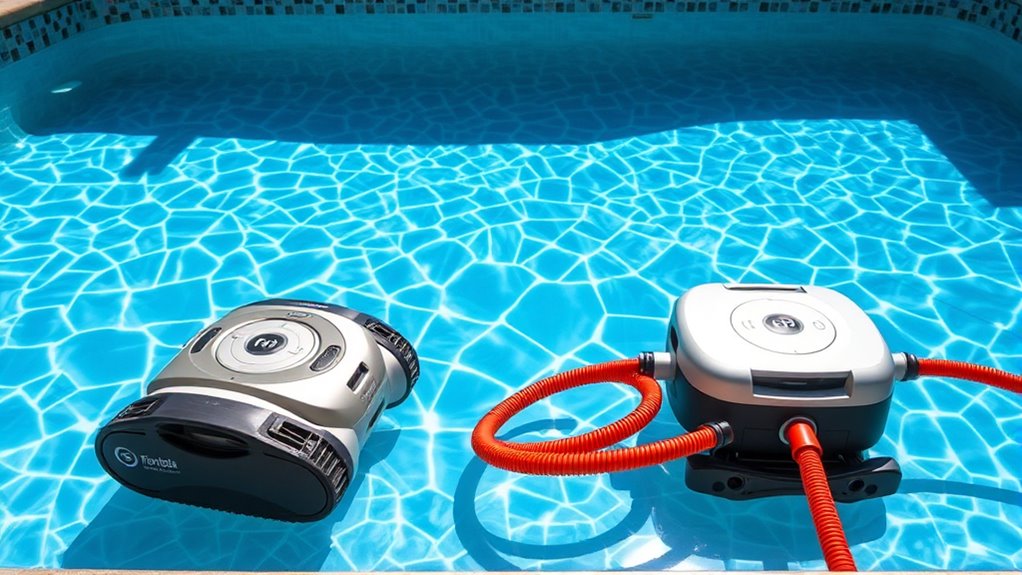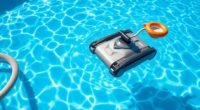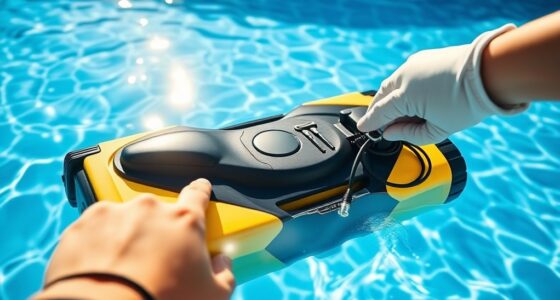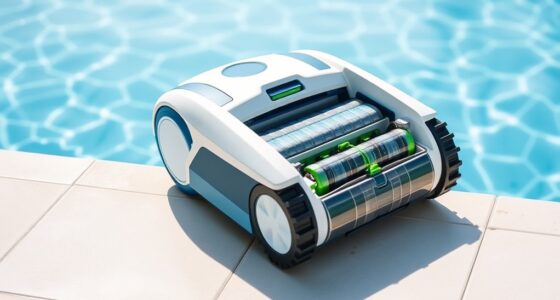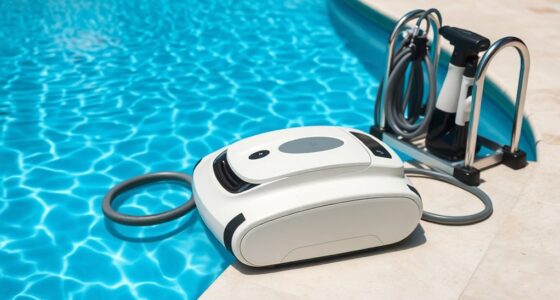Switching from a suction to a pressure pool cleaner involves disconnecting your current device and installing a more powerful system that uses water pressure for better cleaning. First, turn off your pump for safety, then remove the suction cleaner carefully. Next, connect the pressure cleaner’s hose to your pool’s pressure port, ensuring all fittings are tight. Adjust your system if needed for peak performance. If you want to learn more about each step, keep exploring the details.
Key Takeaways
- Verify your pool pump’s flow rate and pressure capacity to ensure compatibility with a pressure cleaner.
- Turn off the pump and disconnect the suction cleaner’s hose from the skimmer before removal.
- Connect the pressure cleaner’s hose securely to the pool’s dedicated pressure port or fitting.
- Adjust the pump’s flow and pressure settings using a regulator or gauge for optimal cleaning performance.
- Regularly inspect and maintain hoses, fittings, and filters to ensure efficient operation and longevity.
Understanding the Differences Between Suction and Pressure Pool Cleaners
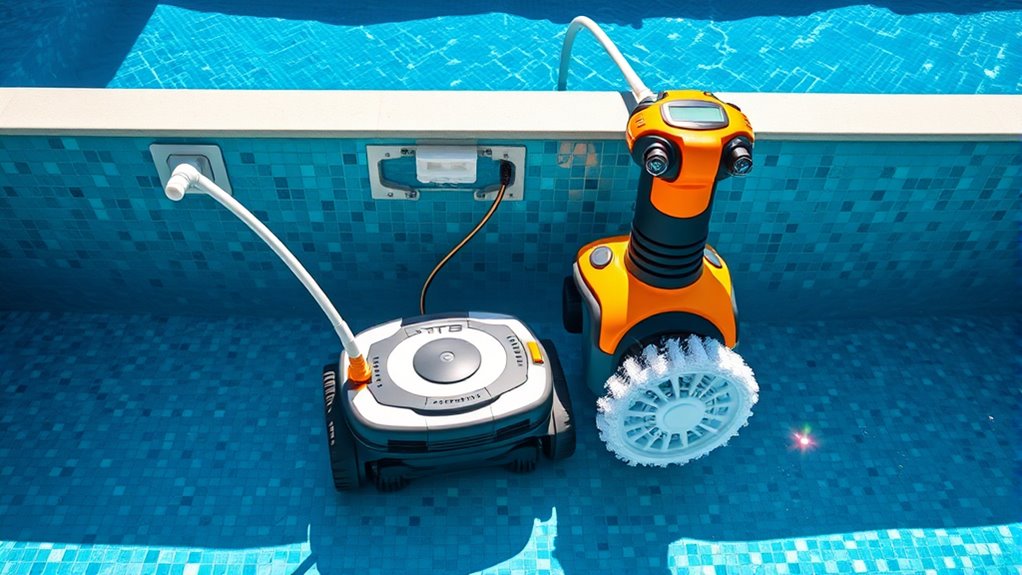
While both suction and pressure pool cleaners keep your pool clean, they operate quite differently. Suction cleaners use your pool’s existing filtration system to generate suction, pulling in debris like leaves, dirt, and small particles through a hose connected to the skimmer. They rely on the pool pump’s vacuum power and have a simple cleaning mechanism. Pressure cleaners, on the other hand, use water pressure supplied by a dedicated booster pump or the pool’s existing pump. They propel themselves around the pool, tackling larger debris such as twigs and leaves with their more active cleaning mechanism. Suction cleaners are typically better for small debris and tight spaces, while pressure cleaners handle larger debris and cover bigger areas more efficiently. Understanding these differences helps you choose the right cleaner for your pool needs. Additionally, considering cleaning efficiency can help determine which type best meets your maintenance requirements. For example, some models are specifically designed to optimize pool cleaning performance, making maintenance more effective and less time-consuming. Moreover, assessing the maintenance requirements of each cleaner can help ensure you select a model that fits your upkeep routine. Recognizing the cost differences between these cleaners can also influence your decision based on budget and long-term use.
Benefits of Upgrading to a Pressure Pool Cleaner

Upgrading to a pressure pool cleaner gives you more cleaning power, making it easier to remove dirt and debris. You’ll also cover your pool faster, saving you time and effort. With these benefits, your pool stays cleaner and ready to enjoy sooner. Additionally, using advanced filtration systems can improve indoor air quality and overall system efficiency, ensuring your pool remains pristine and well-maintained. Incorporating effective track development techniques from trailer music composition can help you streamline your maintenance routines and maintain optimal filtration performance. Proper pressure adjustment is essential to maximize efficiency and prevent issues like overspray or uneven cleaning. Understanding system calibration can further enhance your pool’s cleaning effectiveness and prolong equipment lifespan. Furthermore, paying attention to filter maintenance can prevent clogs and maintain consistent performance.
Enhanced Cleaning Power
Switching to a pressure pool cleaner markedly boosts your pool’s cleanliness by providing more powerful and thorough debris removal. This enhanced cleaning power ensures dirt, leaves, and algae are eliminated more effectively, leaving your pool sparkling. Because pressure cleaners operate with greater suction force, they can reach tricky spots and clean faster, saving you time and effort. Improved cleaning also promotes pool safety by reducing the risk of bacteria buildup and algae growth. Additionally, pressure cleaners are often more energy-efficient, using less power while delivering superior results. This means you can enjoy a cleaner pool without substantially increasing your energy bills. Understanding how different cleaners work can help you choose the best option for your needs. Upgrading to a pressure cleaner is a smart choice for maintaining a safe, pristine, and efficiently cleaned pool year-round. Moreover, the cost-effectiveness of pressure cleaners can make them a worthwhile investment over time. Incorporating modern cleaning technologies often enhances the overall performance and efficiency of your pool maintenance routine. Utilizing advanced cleaning mechanisms can further optimize your pool’s cleanliness and reduce maintenance efforts.
Faster Pool Coverage
A pressure pool cleaner considerably accelerates the cleaning process by covering more area in less time. Its powerful movement allows it to navigate your pool more efficiently than suction models, reducing cleaning cycles. This increased coverage means you spend less time cleaning overall. Since pressure cleaners operate with energy efficiency in mind, they typically use less electricity, leading to cost savings on your energy bills. Additionally, their faster coverage reduces the need for frequent cleanings, saving you both time and money. Upgrading to a pressure pool cleaner ensures your pool stays cleaner longer, thanks to more thorough and quicker cleaning. Overall, this upgrade delivers a smarter, more efficient way to maintain your pool with less effort and lower operating costs.
Assessing Compatibility With Your Pool System
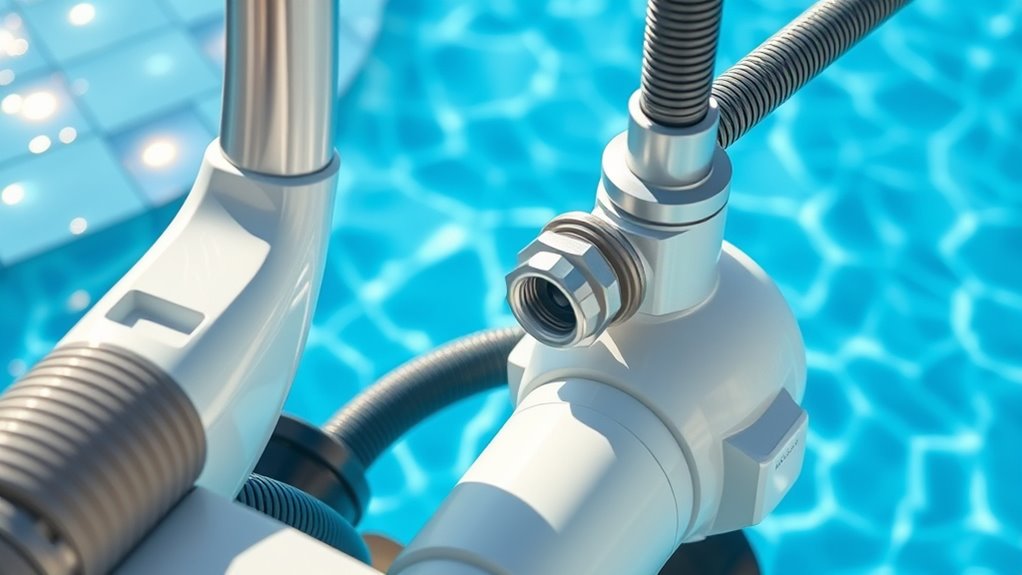
Before switching to a pressure pool cleaner, you need to verify if your pool pump is compatible. Make sure your plumbing system can handle the increased flow and pressure requirements. Taking these factors into account guarantees your new cleaner will work effectively without damaging your system. Additionally, consider your pool’s system compatibility to ensure it can support the new cleaning method effectively. Proper assessment of sprayer performance metrics can help determine if your setup can sustain the necessary pressure and flow rates. Embracing a creative approach to troubleshooting can also uncover innovative solutions to compatibility challenges. Furthermore, understanding security zone info can provide insights into ensuring your pool area remains safe and secure during cleaning operations.
Pool Pump Compatibility
Ensuring your pool pump is compatible with a pressure pool cleaner is crucial for peak performance. A compatible pump maintains proper water flow, which enhances cleaning efficiency and prevents damage to your pool system. Check your pump’s flow rate and pressure capacity to guarantee they meet the cleaner’s requirements. An incompatible pump can compromise pool safety, increasing the risk of leaks or equipment failure, and reduce energy efficiency, leading to higher power bills. It’s essential to review your pump’s specifications and consult manufacturer guidelines. Upgrading to a suitable pump can optimize cleaner operation, promote safer pool use, and save energy over time. Proper compatibility standards and pump specifications ensure your switch from suction to pressure cleaning is smooth, effective, and cost-efficient. Additionally, understanding pool pump compatibility can help you select the right equipment, preventing costly mistakes. Confirming system compatibility can also improve overall pool maintenance and longevity.
Plumbing System Requirements
Your pool’s plumbing system must support the increased water flow and pressure that come with switching to a pressure pool cleaner. To guarantee compatibility, check these key aspects:
- Confirm your plumbing can handle higher flow rates without compromising water filtration efficiency. Proper plumbing capacity is essential to prevent system strain and ensure optimal cleaning performance. Ensuring your system has sufficient irrigation system capacity can help accommodate these increased demands.
- Ensure your system maintains proper chemical balancing, as increased circulation can affect water chemistry.
- Verify that your water filtration components are rated for the added pressure and flow to prevent clogging or damage.
- Considering tableware materials can help you choose durable and compatible plumbing components that withstand higher pressures.
Upgrading your plumbing might be necessary if these elements aren’t compatible. Proper water filtration keeps debris out and maintains water clarity, while balanced chemicals prevent corrosion and damage. Evaluating these factors helps your pressure cleaner operate smoothly and extends its lifespan.
Gathering Necessary Tools and Equipment

To switch from a suction to a pressure pool cleaner, you’ll need to gather the right tools and equipment to guarantee a smooth transition. Start with a comprehensive tool checklist, including a wrench, screwdriver, and pliers, to handle connections and fittings. Make sure you have the pressure-side hose, fittings, and adapters compatible with your pool’s plumbing system. Proper equipment setup is essential, so double-check that your pressure cleaner’s components are complete and in good condition. You might also need a pump regulator or pressure gauge to adjust water flow. Having these tools ready before you begin will streamline the process and prevent delays. Ensuring your tools and equipment are prepared sets a solid foundation for a successful switch from suction to pressure pool cleaning.
Removing Your Existing Suction Pool Cleaner
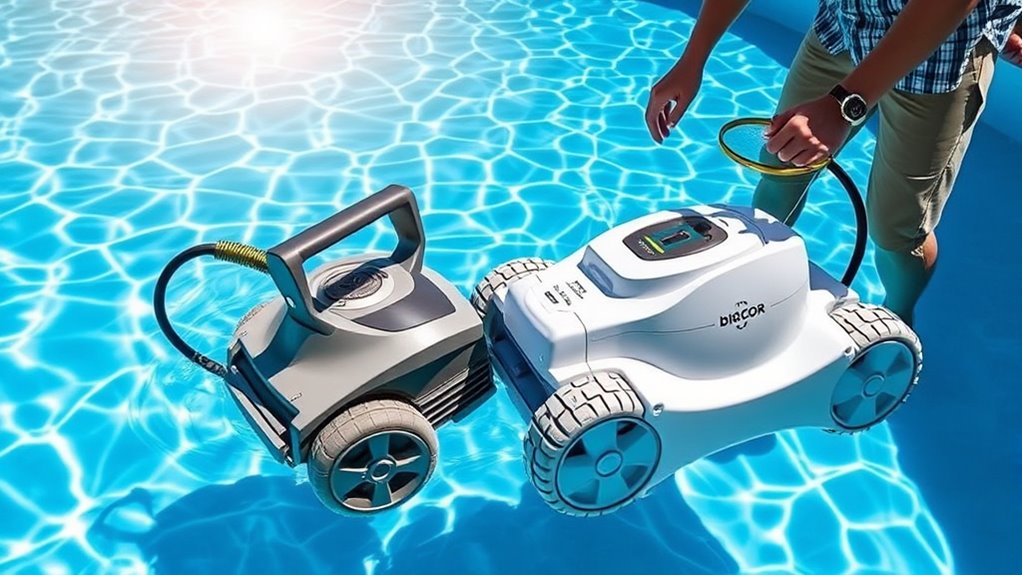
Before installing your pressure pool cleaner, you need to remove the existing suction cleaner. Start by turning off your pool pump to guarantee safety and maintain proper chemical balance. Next, disconnect the hose from the skimmer or dedicated suction port, carefully detaching it to prevent damage. Finally, remove the cleaner itself by loosening any clips or fittings holding it in place, then lift it out of the pool. During this process, check your pool’s safety features, like ensuring no debris is blocking the skimmer, and verify the chemical balance to avoid issues during installation. Proper removal not only prepares your pool for the new cleaner but also helps maintain ideal pool safety and water quality.
Installing the Pressure Pool Cleaner
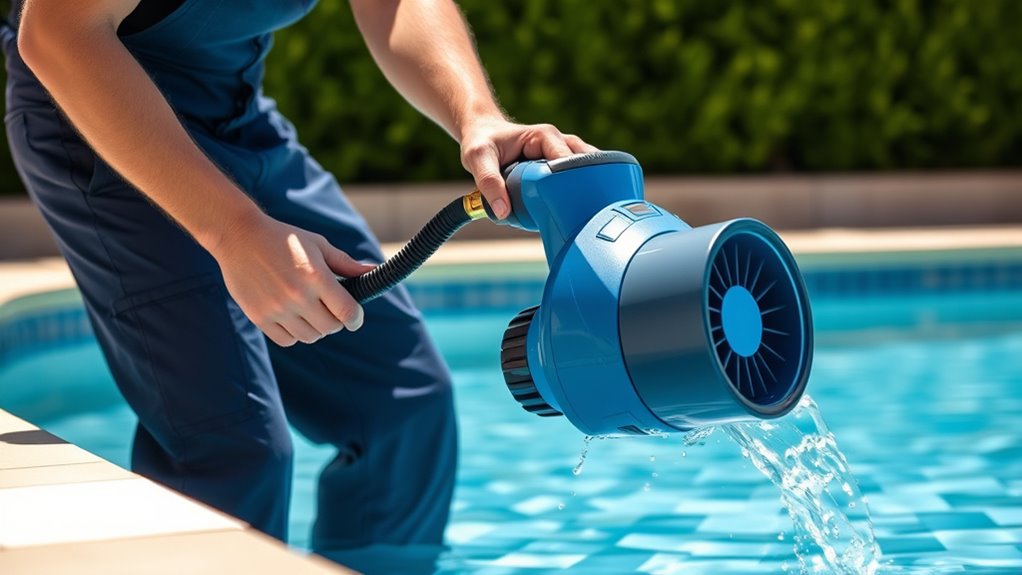
Installing the pressure pool cleaner begins by connecting the hose to the cleaner and the pressure port on your pool’s filtration system. Make sure the hose is long enough to cover your pool’s size, allowing the cleaner to reach all areas effectively. Once connected, confirm the hose is securely attached and free of kinks to maintain proper water flow. The debris capacity of your cleaner determines how well it handles your pool’s typical debris load—larger pools with more debris may require a model with greater capacity. Before turning on the pump, double-check that all connections are tight. This setup ensures that the pressure cleaner operates efficiently, providing thorough cleaning based on your pool’s size and debris levels.
Adjusting Settings for Optimal Performance
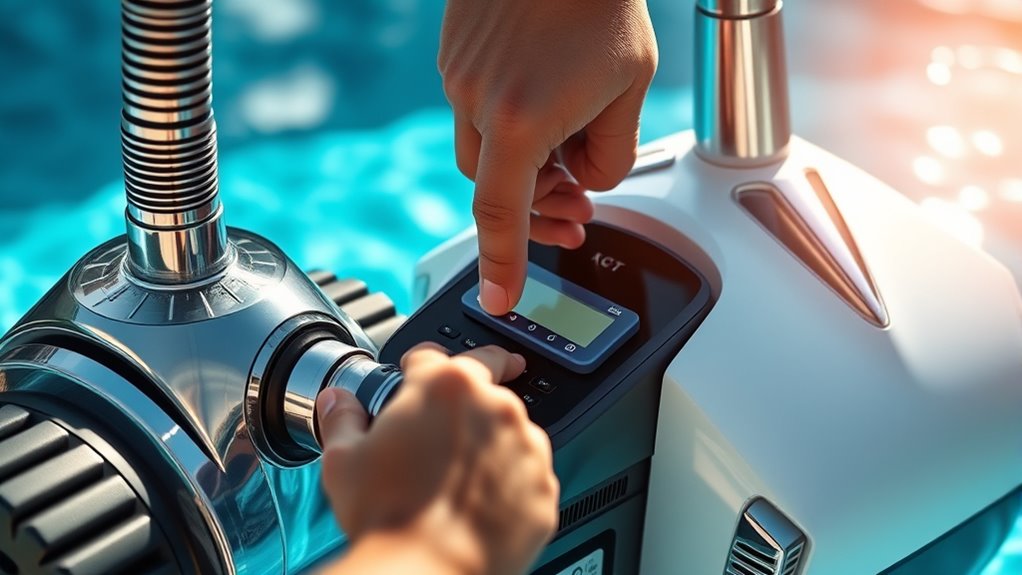
Once your pressure pool cleaner is connected, adjusting its settings is essential to guarantee it performs at its best. Start by selecting the right filter type, such as a fine mesh or standard filter, to maximize debris removal. Next, fine-tune the pressure settings—higher pressure improves debris pickup but may cause the cleaner to move faster; lower pressure offers better control for delicate surfaces. Lastly, verify your filter basket is clean and properly fitted to maintain ideal suction and debris removal efficiency. Regularly adjusting these settings based on debris load and pool conditions will maximize your cleaner’s performance. Proper configuration prevents clogs, extends filter life, and keeps your pool spotless with minimal effort.
Testing and Troubleshooting the New Cleaner
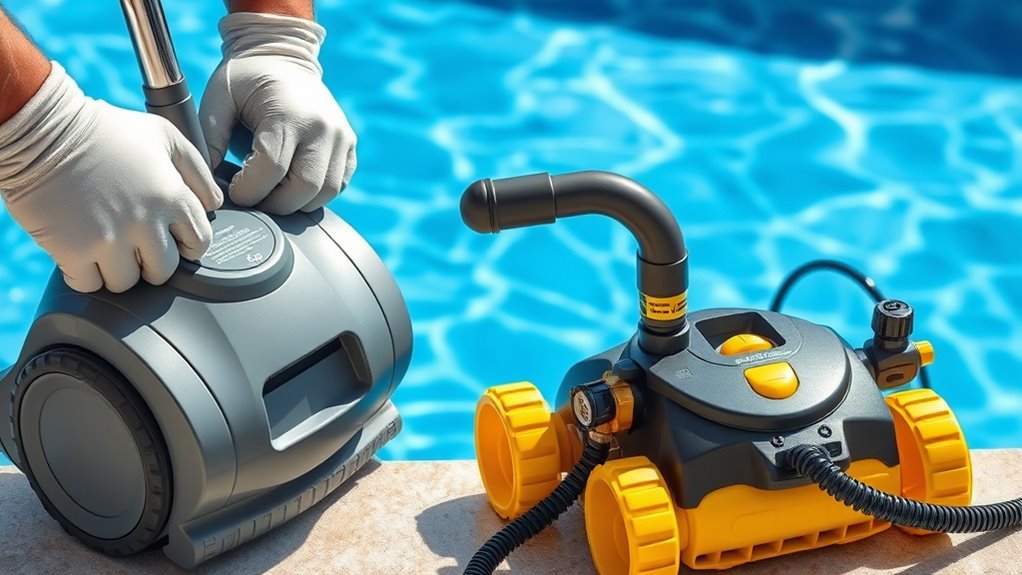
After adjusting your pressure pool cleaner’s settings, it’s important to test its performance to make sure everything runs smoothly. Begin by observing how well it covers your pool surface, checking for missed spots or irregular movement. Keep in mind that pool chemicals can affect the cleaner’s operation, so ensure chemical levels are balanced to prevent issues like clogging or poor suction. Additionally, water temperature can impact the cleaner’s efficiency; colder water may slow down its movement, while warmer water helps it operate smoothly. Run the cleaner for a few cycles, then inspect its brushes and hoses for blockages or leaks. Troubleshoot any problems by adjusting pressure levels or cleaning filters. Proper testing helps make certain your new pressure cleaner works effectively and lasts longer.
Maintaining Your Pressure Pool Cleaner for Longevity
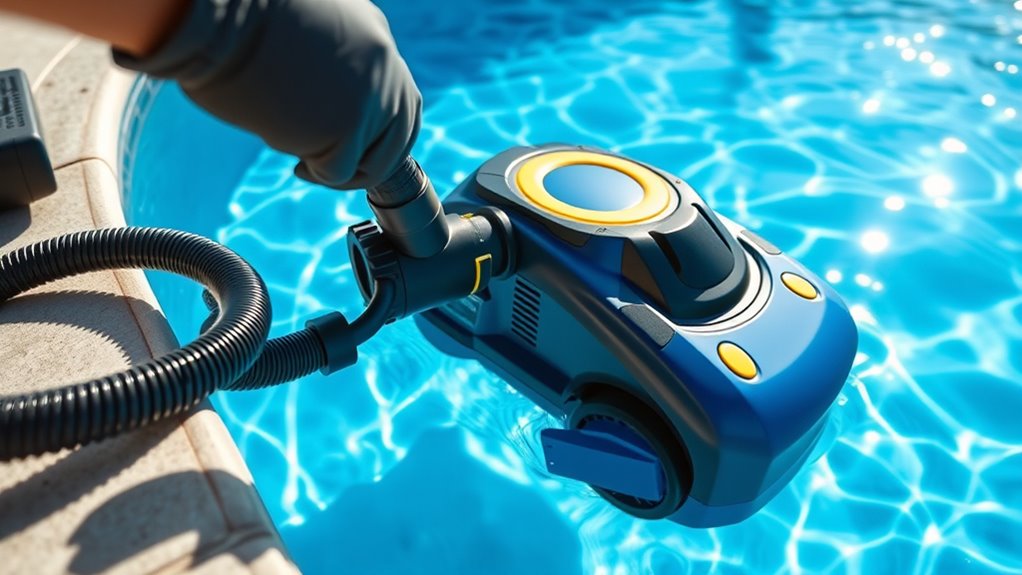
To guarantee your pressure pool cleaner lasts as long as possible, regular maintenance is essential. First, check and adjust your pool chemical levels regularly, as proper balance prevents buildup that can damage the cleaner’s parts. Second, inspect the hoses and nozzles for clogs or wear, replacing any damaged components promptly. Third, monitor water temperature; high temperatures can cause parts to degrade faster, so run the cleaner during cooler times if possible. Additionally, rinse the cleaner after use to remove dirt and debris, and store it in a shaded area to protect it from sun damage. Proper care ensures maximum performance and extends the lifespan of your pressure pool cleaner, saving you money and hassle in the long run.
Frequently Asked Questions
How Often Should I Clean or Replace Parts on My Pressure Pool Cleaner?
You should follow a regular cleaning schedule for your pressure pool cleaner to keep it running smoothly. Inspect and clean the brushes, hoses, and filters weekly, and replace parts like O-rings or worn brushes every few months. If you notice decreased performance or leaks, it’s time for part replacement. Staying on top of cleaning and replacing parts guarantees your cleaner operates efficiently and prolongs its lifespan.
Can I Switch Back to a Suction Cleaner After Upgrading to Pressure?
Yes, you can switch back to a suction pool cleaner after upgrading to a pressure model, but check your pool’s compatibility first. Not all pool setups support switching pool cleaners easily, so verify your skimmer and fittings are compatible. You’ll need to disconnect the pressure cleaner and reattach your suction model properly. Always follow manufacturer instructions for switching pool cleaners to avoid damage and guarantee maximum cleaning performance.
Does a Pressure Cleaner Require More Maintenance Than a Suction Model?
Imagine your pool cleaner as a diligent worker—pressure models often require more maintenance because their parts face greater wear and tear. You’ll notice higher maintenance frequency and more part replacements compared to suction cleaners. Pressure cleaners have complex mechanisms, so keeping them in top shape means regular checks and timely replacements. This added attention guarantees your cleaner runs smoothly, but it does mean more ongoing maintenance than simpler suction models.
Will My Existing Pool Filter System Handle the Pressure Cleaner Effectively?
You might wonder if your pool filter system can handle a pressure cleaner. Check your filter’s compatibility by reviewing its specifications and guaranteeing it matches the pressure ratings required for the pressure cleaner. Most filter systems designed for pressure cleaners have appropriate ratings, but if you’re unsure, consult your manufacturer or a professional. Proper compatibility ensures efficient cleaning and prevents damage to your equipment.
Are There Specific Brands or Models Recommended for Compatibility?
When choosing a pressure pool cleaner, you should consider brand compatibility and model recommendations to guarantee smooth operation. Look for reputable brands like Polaris, Hayward, or Zodiac, which are known for compatibility with various pool systems. Check the model specifications to confirm they match your pool’s size and your filter system’s capacity. Doing this helps you avoid issues and guarantees effective cleaning performance with your existing setup.
Conclusion
Switching from a suction to a pressure pool cleaner is a smooth, simple switch that boosts your pool’s brilliance. By understanding the differences, determining compatibility, and diligently installing and adjusting, you guarantee your cleaner’s climb to peak performance. Regular maintenance maximizes longevity, keeping your pool pristine and perfect. Make the move, master the method, and marvel at the magnificent, maintenance-free pool moments that follow. Your sparkling, spotless pool is just a switch away!
